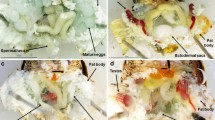Summary
Oncopeltus fasciatus exhibits a facultative reproductive diapause which is triggered by short photoperiods. The duration of the triggering photoperiod (the “critical photoperiod”) is a function of the environmental conditions under which populations are reared. Some individuals are apparently sensitive to critical photoperiods in the early instars, but maximum sensitivity, indicated by 100% diapause, occurs in the late 5th instar during development of the pharate adult. Sixty per cent retain sensitivity into the first five days of adulthood. Temperatures of 27°C can prevent diapause. Once initiated, diapause can be broken either by raising the temperature or increasing the day length; it is broken abruptly, for once oviposition starts, it proceeds at maximum rate. Diapause contributes significantly to a migratory strategy in the temperate parts of the range of O. fasciatus and probably does so in the tropics as well.
Similar content being viewed by others
References
Barry, B. D., Atkinson, P. L.: Certain aspects of the genetic factors involved in the control of the larval diapause of the pink bollworm. Ann. ent. Soc. Amer. 59, 122–125 (1966)
Beck, S.DD.: Insect photoperiodism. New York: Academic Press 1968
Beck, S. D., Apple, J. W.: Effects of temperature and photoperiod on voltinism of geographical populations of the European corn borer, Pyrausta nubilalis. J. econ. Ent. 54, 550–558 (1961)
Caldwell, R. L.: A comparison of the migratory strategies of two milkweed bugs, p. 304–316. In: L. Barton Browne, Ed., Experimental analysis of insect behaviour. Berlin-Heidelberg-New York: Springer 1974
Danilevskii, A. S.: Photoperiodism and seasonal development of insects. Edinburgh: Oliver and Boyd 1965
Danilevsky, A. S., Goryshin, N. I., Tyschenko, V. P.: Biological rhythms in terrestrial arthropods. Ann. Rev. Ent. 15, 201–244 (1970)
Dingle, H.: Some factors affecting flight activity in individual milkweed bugs (Oncopeltus). J. exp. Biol. 44, 335–343 (1966)
Dingle, H.: Life history and population consequences of density, photoperiod, and temperature in a migrant insect, the milkweed bug Oncopeltus. Amer. Natur. 102, 149–163 (1968a)
Dingle, H.: The influence of environment and heredity of flight activity in the milkweed bug Oncopeltus. J. exp. Biol. 48, 175–184 (1968b)
Dingle, H.: Migration strategies of insects. Science 175, 1327–1335 (1972)
Dingle, H.: The experimental analysis of migration and life history strategies in insects, p. 329–342. In: L. Barton Browne, Ed., Experimental analysis of insect behaviour. Berlin-Heidelberg-New York: Springer 1974
Dingle, H., Caldwell, R. L.: Temperature and reproductive success in Oncopeltus fasciatus, O. unifasciatellus, Lygaeus kalmii, and L. turcicus. Ann. ent. Soc. Amer. 64, 1171–1172 (1972)
Dingle, H., Hegmann, J. P.: The nature of genetic variance influencing diapause in a migrant insect, Oncopeltus fasciatus. In preparation.
Harvey, G. T.: The occurrence and nature of diapause-free development in the spruce budworm, Choristoneura fumiferana (Clem.) (Lepidoptera: Tortricidae). Canad. J. Zool. 35, 549–572 (1957)
Honěk, A.: Selection for non-diapause in Aelia acuminata and A. rostrata (Heteroptera, Pentatomidae) under various selective pressures. Acta ent. Bohemoslov. 69, 73–77 (1972)
Lees, A. D.: The physiology of diapause in arthropods. Cambridge: Cambridge University Press 1955
Morris, R. F., Fulton, W. C.: Heritability of diapause intensity in Hyphantria cunea and correlated fitness responses. Can. Ent. 102, 927–938 (1970)
Rankin, M. A.: The hormonal control of flight in the milkweed bug, Oncopeltus fasciatus, p. 317–328. In: L. Barton Browne, Ed., Experimental analysis of insect behaviour. Berlin-Heidelberg-New York: Springer 1974
Slater, J. A.: A catalogue of the Lygaeidae of the world. Storrs: University of Connecticut Press 1964
Tauber, J. J., Tauber, C. A.: Geographic variation in critical photoperiod and in diapause intensity of Chrysopa carnea (Neuroptera). J. insect Physiol. 18, 25–29 (1972)
Waldbauer, G. P., Sternburg, J. G.: Polymorphic termination of diapause by Cecropia: genetic and geographical aspects. Biol. Bull. 145, 627–641 (1973)
Author information
Authors and Affiliations
Rights and permissions
About this article
Cite this article
Dingle, H. Diapause in a migrant insect, the milkweed bug Oncopeltus fasciatus (Dallas) (Hemiptera: Lygaeidae). Oecologia 17, 1–10 (1974). https://doi.org/10.1007/BF00345090
Received:
Issue Date:
DOI: https://doi.org/10.1007/BF00345090




